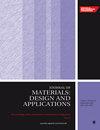利用工业废塑料芯、麻织物和虾壳粉生产可持续聚酯复合建筑材料:准各向同性纤维堆叠和颗粒负载的影响
IF 2.2
4区 材料科学
Q3 MATERIALS SCIENCE, MULTIDISCIPLINARY
Proceedings of the Institution of Mechanical Engineers, Part L: Journal of Materials: Design and Applications
Pub Date : 2024-07-26
DOI:10.1177/14644207241267123
引用次数: 0
摘要
本研究调查了使用废塑料芯、麻纤维和虾壳粉制备的商用胶合板(6 毫米)替代聚酯复合材料的机械、疲劳和蠕变性能。这项研究的主要目的是开发一种可完全替代胶合板的建筑材料,并研究纤维堆叠顺序以及虾壳生物聚合物的体积分数对承载性能和随时间变化的性能的影响。根据 ASTM 标准,通过压缩成型制备了不同麻纤维角度和虾填充物含量(0%、1.0% 和 3.0%)的复合材料,并对其进行了测试。结果表明,"D "堆积顺序{(-45/45) + (-30/60) + WPC + (-60/30) + (-45/45)} 复合材料的机械强度始终优于其他材料。具体而言,D2 复合材料表现出更高的强度,包括 168 兆帕的拉伸强度、199 兆帕的弯曲强度、181 兆帕的压缩强度、6.23 焦耳的冲击能、25.9 兆帕的层间剪切强度和 19.7 兆帕的 V 型槽轨剪切强度。富含羟基的虾填料的加入增强了分子间的相互作用,有助于形成弹性网络并提高抗疲劳性。此外,准各向异性排列对抗蠕变性能也有显著影响,其中 "D "代号的性能最佳。显微分析表明,虾壳成分在促进内聚力和交错纤维结构方面起着关键作用。这些发现强调了堆叠角、填料成分和含量之间错综复杂的协同作用,有助于生产出坚固耐用的环保型聚酯复合建筑材料,以取代受白蚁、天气和水影响的商用胶合板。本文章由计算机程序翻译,如有差异,请以英文原文为准。
Production of sustainable polyester composite building material using industrial waste plastic core, hemp fabric, and shrimp shell powder: Effect of quasi-isotropic fiber stacking and particle loading
This study investigates the mechanical, fatigue, and creep properties of commercial plywood (6 mm) alternative polyester composite prepared using waste plastic core, hemp fiber, and shrimp shell powder. The primary aim of this research was to develop an exact replacement for plywood building material and study the effect of fiber stacking order as well as the volume fraction of shrimp shell biopolymer on load-bearing and time-dependent properties. Composites' distinct quasi-isotropic stacking orders with varying hemp fiber angles and shrimp filler contents of 0%, 1.0%, and 3.0% were prepared via compression molding and tested based on ASTM standards. Results revealed that the “D” stacking order {(−45/45) + (−30/60) + WPC + (−60/30) + (−45/45)} composite consistently outperformed others, exhibiting superior mechanical strength. Specifically, the D2 composite exhibited elevated strength, including a tensile strength of 168 MPa, flexural strength of 199 MPa, compression strength of 181 MPa, impact energy of 6.23 J, interlaminar shear strength of 25.9 MPa, and v-notch rail shear of 19.7 MPa. The addition of shrimp filler, rich in hydroxyl groups, enhanced intermolecular interactions, contributing to a resilient network and improved fatigue resistance. Moreover, the creep resistance was notably influenced by the quasi-isotropic arrangement, with the “D” designation showcasing optimal performance. Microscopic analysis revealed the critical role of shrimp shell content in promoting cohesion and interlocking fiber structures. The findings underscore the intricate synergy between stacking angles; filler composition and content in achieving robust and eco-friendly polyester composite building material to replace the termite, weather, and water affect commercial plywood.
求助全文
通过发布文献求助,成功后即可免费获取论文全文。
去求助
来源期刊

CiteScore
4.70
自引率
8.30%
发文量
166
审稿时长
3 months
期刊介绍:
The Journal of Materials: Design and Applications covers the usage and design of materials for application in an engineering context. The materials covered include metals, ceramics, and composites, as well as engineering polymers.
"The Journal of Materials Design and Applications is dedicated to publishing papers of the highest quality, in a timely fashion, covering a variety of important areas in materials technology. The Journal''s publishers have a wealth of publishing expertise and ensure that authors are given exemplary service. Every attention is given to publishing the papers as quickly as possible. The Journal has an excellent international reputation, with a corresponding international Editorial Board from a large number of different materials areas and disciplines advising the Editor." Professor Bill Banks - University of Strathclyde, UK
This journal is a member of the Committee on Publication Ethics (COPE).
 求助内容:
求助内容: 应助结果提醒方式:
应助结果提醒方式:


